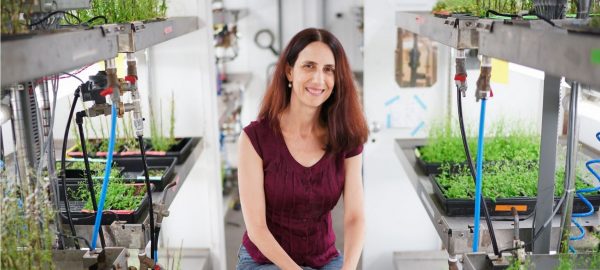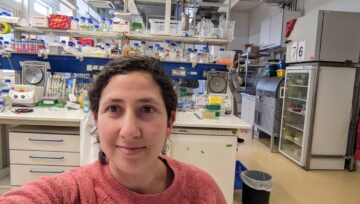SPOTLIGHT ON RESEARCH
PAPER OF THE MONTH AUGUST 2023
The Committee for Graduate Studies in the Faculty of Biology selects the leading scientific article each month from all the scientific articles published for that month.
We are pleased to announce that the winner of August’s article is Bader Rayan from Prof. Landau’s lab. The article was published in Frontiers in Molecular Biosciences.
On the occasion of the win, we asked Bader to provide us with some interesting details about the study and the path that led to the research, and a bit about him.
Hi, could you introduce yourself in a few words?
My name is Bader, I am 29 years old and from the village of Kabul, I have lovely and supportive parents, and next week I am getting married to my love, Hiba, who is also a Ph.D. student in the Faculty of Biology. I studied for a bachelor’s degree in pharmacy at the Hebrew University in Jerusalem, after which I worked for several years as a pharmacist. In 2021 I started my master’s degree in Prof. Meytal Landau’s laboratory, and after a year I switched to the Ph.D. direct path.
Could you explain what Prof. Landau’s laboratory is all about?
The Landau Lab is a multidisciplinary laboratory that combines various research fields such as biochemistry, biophysics, and structural biology. We in the lab are interested in studying antimicrobial/virulent peptides with the ability to form fibrils, where some of these fibrils arrange themselves into very ordered and stable structures that resemble the structures of amyloids. While amyloids have some common properties, they differ significantly between organisms. In humans, amyloids are associated with neurodegenerative diseases such as Alzheimer’s and Parkinson’s. On the other hand, bacterial amyloids contribute to biofilm formation, allowing bacteria to adhere to and resist harsh environments. In amphibians, amyloids formed from antimicrobial peptides aid in their immune defense against pathogens.
In the laboratory we are trying to understand what makes the group of functional amyloids unique so that they are created by a wide variety of organisms, we are trying to investigate this using different methods and combining different fields to understand the relationship between structure and activity, something that can ultimately greatly promote the development of new and super stable anti-microbial agents.
Could you tell us about your current article/research what was the main purpose of the research and what did you discover?
The aim of the study was to investigate the thermal stability of two functional amyloid peptides called PSMα1 and PSMα3, these two peptides are secreted by the virulent bacterium Staphylococcus aureus, and although they are homologous peptides they differ in their structure and function. This fact was very intriguing and based on it we wanted to delve into understanding the relationship between the structure and activity of these two peptides. In this study, we discovered that when PSMα1 is exposed to a heat shock of 80°C, it forms amyloid structures called cross-β, which leads to a loss of cytotoxic activity (cell killing), which is consistent with its role in biofilm stability. In contrast, the cross-α fibrils of PSMα3 disintegrate when exposed to a heat shock of 80°C, resulting in a total regain of the cytotoxic activity. We propose that the disaggregation of PSMα3 into soluble populations under stress allows it to interact with membranes and this is critical for its toxic process and reversible biological activity.
Can you elaborate on the importance of the discovery? How will it serve you and what directions does it take? What is the application of the discovery (domains, solutions)?
The research provides valuable insights into these virulent peptides behavior and functional roles under different conditions. The study highlights the differential thermostability of PSMα1 and PSMα3, unveiling potential opportunities for targeted interventions. Additionally, it sheds light on the PSMα3 toxic process and the reversible modulation of its biological activity under stress conditions. The findings are relevant to microbiology, biochemistry, and infection control, offering potential applications in combating staphylococcal infections and biofilm-related research. This discovery opens new avenues for infectious disease research.
What drew you to the current lab/project?
What attracted me at first was the topic that the lab deals with. I came from the field of pharmacy and am aware of the lack of development and research of new antibiotic drugs, and I really wanted to be part of the people who would contribute to the advancement of this research. In addition, I was very impressed with Meytal as a supervisor from my first conversation with her, I realized then that I was coming to a place that allows for personal growth. Meytal is a unique supervisor in my opinion, she puts full trust in her students, and together with her each student builds the nature of his research for himself. In addition, Eilon, the laboratory manager, supported me a lot during the stages of my admission to the laboratory, from then until today I do not remember a single day when I did not ask him for scientific advice or even life advice. Eilon’s guidance promoted me a lot, especially in exercising critical thinking, and I think that Elon has a significant part in who I am today!
When you are not “doing” science, what do you do?
Play football.
what are your plans for the future of your career?
I really want to continue my post-doctoral studies in order to continue to grow and advance, and of course to contribute to science and society. I also want to be an example to the youth and students of my society and inspire others to never give up and always dream, because I believe that the sky is the limit.
➡ Click here to read the full article









